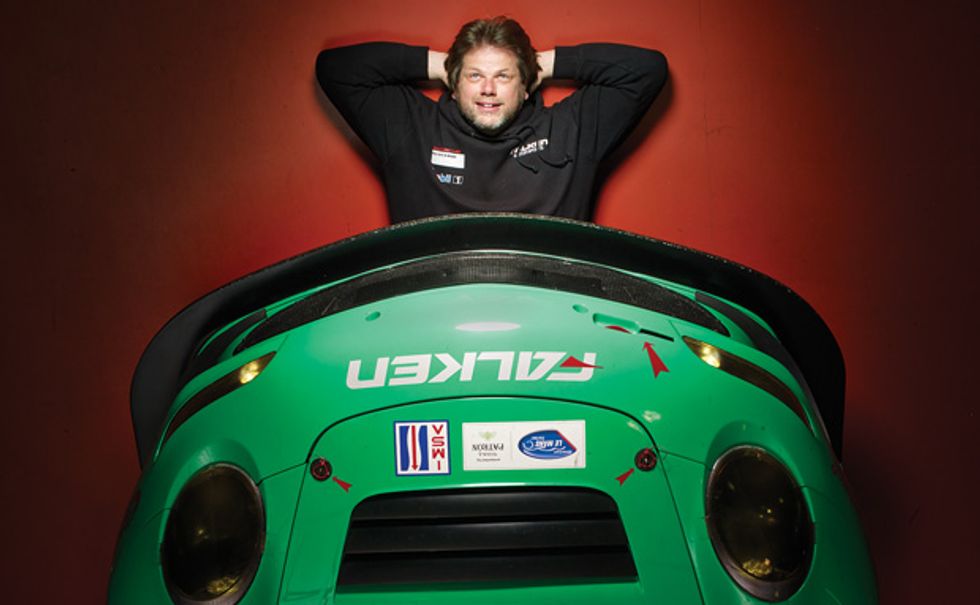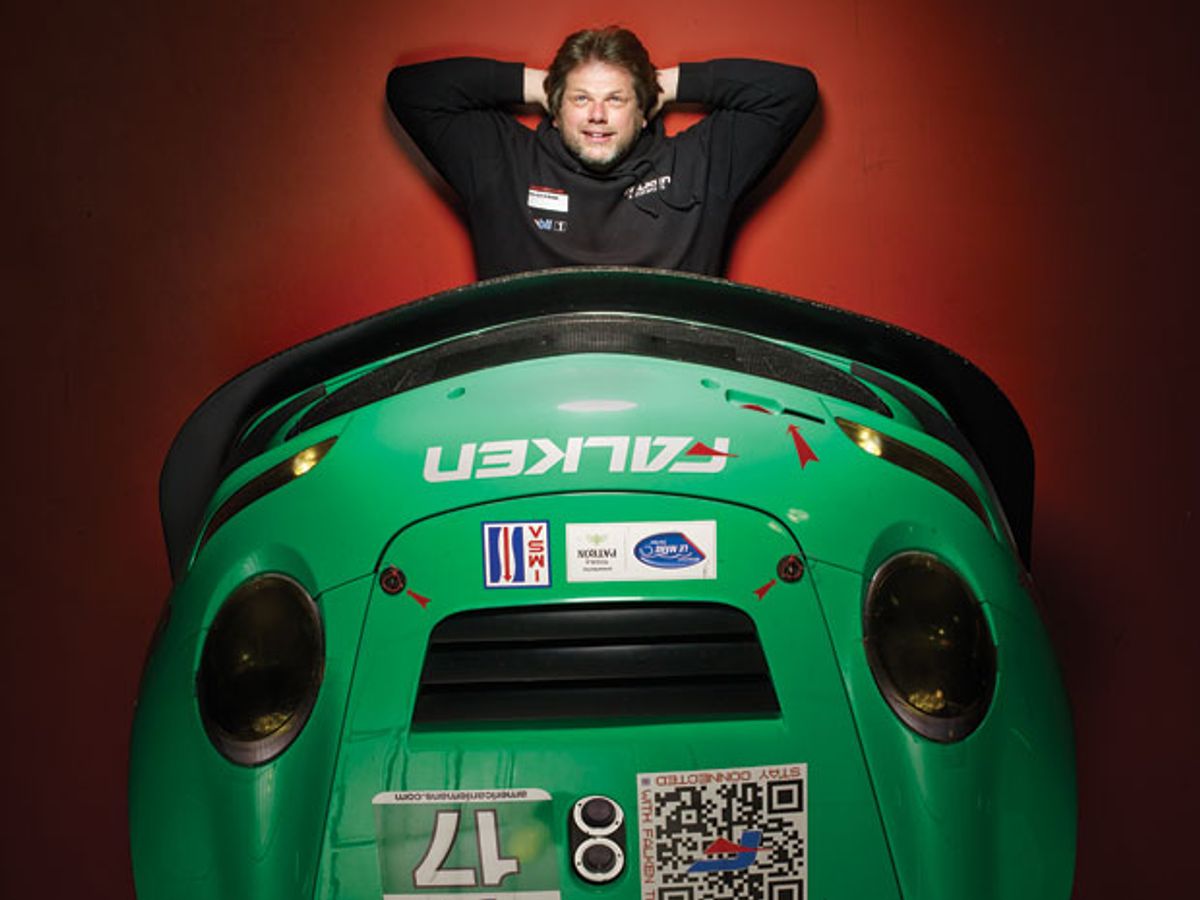
Last August, a sleek blue-and-green Porsche sped at more than 200 kilometers per hour as it headed into “the kink,” a sinuous section of the Road America racetrack in Elkhart Lake, Wis. The car, a US $650 000 911 GT3 RSR, was just minutes from its final pit stop in this four-hour race, one of the American Le Mans Series, when it went careening off the course. The race was over for Team Falken Tire, but the fun was just beginning for its data-acquisition engineer, Rick Mahurin, who had been monitoring the entire episode via telemetry.
Just before the car went out of control, the driver, Bryan Sellers, had “radioed that he felt vibrations in the rear left tire,” says Mahurin. And then “all of a sudden he lost pressure and spun into the fence.” The tire disintegrated, and one of the car’s fenders was crushed, but Sellers walked away unscathed.
Oddly, the car’s extensive sensor network gave Mahurin no warning of the blowout. Although disappointed that the data stream from the car prevent the crash, Mahurin looked forward to reengineering the car’s wheel-sensor system to better detect incipient failures.
Vital Stats:
Name: Rick “Ricky” Mahurin
IEEE Member: Yes
Age: 49
What he does: Data-acquisition engineer
For whom: Walker Racing
Where he does it: Indianapolis, and on racetracks throughout the world
Fun facts: Hacks race cars to help get them around the track that much faster.
At age 49, Mahurin, who has spent half his life in racing, thrives on high velocities. “When everything starts to speed up, I get in my element,” he says. “It’s when things are slow that I’m uncomfortable.”
This predilection might be genetic: “I think it’s an Asperger’s thing,” he says. Although he has never been diagnosed with this syndrome, his son has—and “he’s just like me,” says Mahurin. “The way I’ve heard it described is that your brain goes so fast other people can’t really relate to it.” If so, it’s no wonder he ended up in auto racing, which attracts a lot of people who would languish in more conventional jobs, Mahurin declares. “The racing industry is basically a mental health ward,” he quips.
Modern race cars are stuffed with sensors. Mahurin’s has more than 300 of them, measuring such parameters as tire pressure, engine speed, cockpit temperature, and steering-wheel angle. As cars fly by him on the track, he sits in the pit and concentrates on three computer screens, which provide continuously updated plots of data beaming from the Porsche. If he notices any measurements creeping outside their normal ranges, he radios an alert to the crew chief, who is also in the pit but unable to hear anything above the din beyond what is sent to his headphones.
A history of devising clever tech fixes has burnished Mahurin’s reputation among racecar engineers. For example, he found a fresh solution to an old problem—determining exactly how much fuel a car has when it rolls in for a pit stop. That’s tricky information to get for race cars because they use rubber bladders to hold fuel, making it impossible to gauge fuel level with a conventional float. Mahurin’s insight was to rig the car with scales that could measure the weight of the remaining gas so that during hurried pit stops the crew would know exactly how much they needed to put in.
A large part of Mahurin’s job is coming up with such technical fixes, and making them as economically as possible. “We don’t have an unlimited budget,” he says. “I’m able to sort of MacGyver things.” At one race, his team was preparing for a test run when he and his crewmates discovered that some of their equipment had gotten lost in transit. “We didn’t have any antennas for our telemetry or radios,” he recalls with a laugh. “So I made them out of a coat hanger. We hung it up, and it was marvelous. They didn’t want to buy antennas anymore.”
Mahurin got his first taste of motorsports culture as a youngster when he went to local drag races with his brothers. Later he enrolled at Purdue University, starting out in computer technology before switching to mechanical engineering. One of his classmates at the time was working for a shop that built engines for cars racing in the Indianapolis 500. “All the parts were shiny and really intricate,” he says. “I realized this is the place I needed to be.”
To get there, he started talking with people in the business and was soon working in racing shops, helping to design and build components while he continued his engineering studies in the evenings. “Once I finished my degree, I just stayed in racing,” he says. “I was a kid in a candy store.”
If you want to work in racing, Mahurin says, get to know some teams. Although the industry is fickle, with teams going in and out of business every year, talented people can find stable careers: The key is being a “known quantity,” he insists. “Once you get a reputation for being somebody who can get it done, that’s pretty much all you need.”
His career demonstrates as much. Mahurin has been employed by nine different racing teams and companies over his 25 years in the business, including his current two-year stint with Walker Racing, which Falken Tire Corp. has contracted to run its racecar endeavors.
As much as he loves the excitement of the track, Mahurin also enjoys the behind-the-scenes tinkering between races. After the crash at Road America, for example, he spent a week scrutinizing the sensors on the car to be sure they weren’t damaged. He installed some new electronics for collecting and processing the raw sensor readings as well as junction boxes designed to simplify the wiring of the car’s onboard video system. The following week, at a track in Baltimore, his brain raced in parallel with the Porsche as he watched it cross the finish line first.
Silicon and software, as much as rubber and steel, made that win possible, Mahurin notes proudly. “When the systems that you have in place enable you to do your job, and it all comes out the way it’s supposed to, it’s a joy.”
An abridged version of this article appeared in print as "Motorsport MacGyver."
About the Author
Alaina G. Levine has not only interviewed many people with fabulous jobs, she’s also helped many people to get them. Levine runs Quantum Success Solutions, where she provides career consulting, among other services, including writing and “corporate comedy.” She holds bachelor’s degrees in mathematics and anthropology from the University of Arizona, where she formerly worked as director of special projects for the College of Science. For more about the author, see the Back Story, "A Day at the Races."
